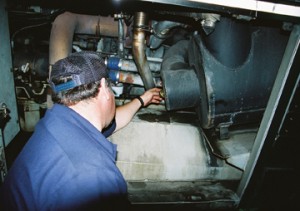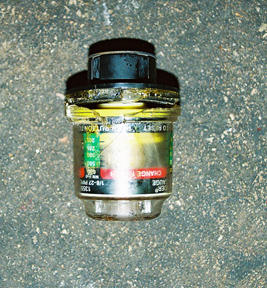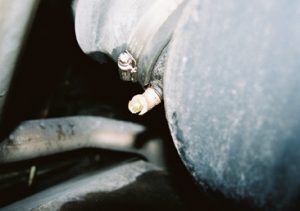By Christopher W. Ferrone

Even after 30-plus years in this business, I still discover on occasion something in our garage that scares me into action.
For about a week I had been hearing a high-pitched whistling noise coming from an S-60 engine. I inspected it and drove it personally, but was still unable to locate the source. With a little more probing, I eventually diagnosed the disturbing noise as coming from the air intake system on the engine.
The old-school way to locate an intake leak is to spray the intake ducting with starting fluid, which increases engine RPMs. I tried this test procedure, but still could not pinpoint the whistling.
Finally after a few hours of looking over the engine and ducting, I located a cracked air filter restriction indicator. Mounted on the intake duct, the crack was very small and hard to see. I was able to see the crack better once I took it off the duct, and immediately understood the problem with the failed filter indicator in photo 1. Air was entering through the crack in the indicator and making the whistling noise.
My point here is how one $10 filter indicator could have wiped out the $20,000 engine; proof that attention to the air cleaner is one of the most important details in engine maintenance. This is how the engine breathes.
The filter indicator is mounted downstream (photo 2) of the air cleaner. If it cracks and allows air to enter the intake ducting, it is unfiltered air that is entering the engine. Similar to a human breathing air that is not clean and feeling it in the lungs.As miles and engine hours elapse and mount up, a large quantity of dirty unfiltered air will have entered the engine and caused damage to the all the air-side components.
At least three conditions can negatively affect the filter indicator: age, heat and solvents. Any one of these — together or separately — can cause this type of crack failure in the body of the indicator.



At Chicago Sightseeing we change out all the air cleaners in the fleet regularly on a three-month cycle, which equates to about 10,000 miles. This service schedule has worked well for our engines since our fleet has a high percentage of idle time per day. By changing these filters according to a strict timetable — rather than by going on the current condition of the filter — we do not need the indicator in our garage.
As a result, we also have systematically removed all filter indicators fleet wide and replaced them with brass plugs, eliminating the need for an indicator all together. These brass plugs are easy to find and easy to install (photo 3). This change over procedure has eliminated an unnecessary risk that had no benefit to our fleet.
For any coach operator experiencing the same sort of failure, my advice is to immediately remove the damaged indicator and replace it with a new one if the choice is to keep using it, or install the plugs and eliminate the indicator.
An additional step is to determine if dirty air entering the engine has done any damage. Remove the turbocharger intake duct and inspect the turbocharger compressor vanes. If the vanes appear to be pitted or their edges eroded, too much dirty air has entered the engine and damaged the turbocharger, and most likely the air-side components of the engine as well.
This problem becomes all the more deceptive because it seems so simple to the casual observer. However, if ignored, it could mean replacing a new engine instead of a mere indicator. In maintenance it is always the simple mundane problem in the first place that often leads to the larger and more difficult problems.
Christopher W. Ferrone is president of Americoach Systems, Inc., Glenview, IL, an engineering firm specializing in transportation technology, analysis and engineering safety.
